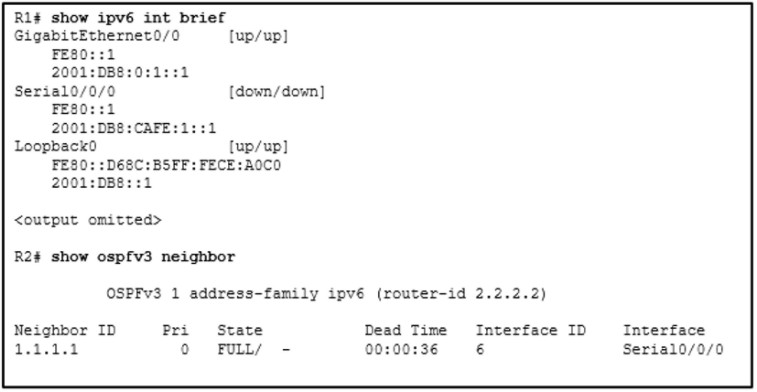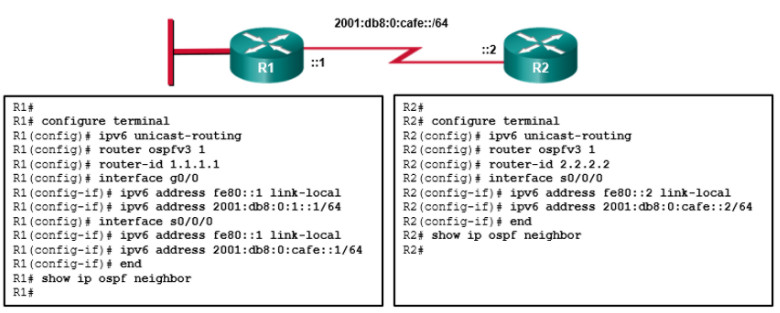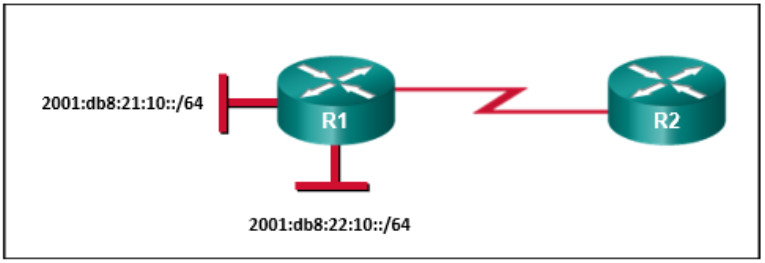25. Which statement describes a difference or similarity between OSPFv2 and OSPFv3?
- OSPFv2 requires the DR/BDR election to occur on multiaccess networks only, whereas OSPv3 requires DR/BDR elections for all network types.
- Both OSPFv2 and OSPFv3 use the router configuration
networkcommand to advertise networks. - Both OSPFv2 and OSPFv3 use multicast destination addresses for link-state packets.
- OSPFv2 uses a 32 bit router ID and OSPFv3 uses a 128 bit router ID.
26. Refer to the exhibit. What address will R2 use as the destination address for sending OSPFv3 link-state request packets to R1?

- fe80::1
- 2001:db8:cafe:1::1
- 2001:db8::1
- ff02::5
27. Refer to the exhibit. Routers R1 and R2 are configured as shown. However, the show ipv6 ospf neighbor command reveals that there are no OSPFv3 neighbors established. What error in the configuration is preventing neighbor relationship from forming between the two routers?

- OSPFv3 is not enabled on the interfaces.
- The IPv6 routing process is not enabled.
- There is a link-local address conflict between the serial and gigabit interfaces on R1.
- The IPv6 address family is not initialized on either router.
28. How are OSPFv3 interarea routes identified in the routing table?
- OI
- IA
- O
- EX
29. Refer to the exhibit. Which configuration on R1 would advertise a summary route of the two LANs to R2?

- area 0 range 2001:db8:10::/44
- area 0 range 2001:db8:11::/48
- area 0 range 2001:db8:20::/44
- area 0 range 2001:db8:21::/48
30. When configuring OSPFv3 summarization, on which router should summarization be configured?
- ABR
- ASBR
- DR or BDR
- any OSPFv3 router in the domain
31. Which LSA type is generated by all OSPFv3 routers to describe the state and cost of interfaces in an area?
- type 1
- type 2
- type 3
- type 4
32. What is the instance ID range reserved for the IPv4 unicast address family in OSPFv3?
- 33-63
- 65-95
- 97-127
- 128-191
33. What must be done as a prerequisite to starting the OSPFv3 process on a Cisco router?
- initialize the IPv6 routing process
- define the router ID
- initialize the IPv6 address family
- assign IPv6 addresses to interfaces
34. Which two OSPFv3 LSA types are used to advertise IPv6 unicast address prefixes and prevent the need for SPF calculations every time an address prefix is added or changed on a router interface? (Choose two.)
- LSA type 4 – inter-area router
- LSA type 5 – AS-external
- LSA type 7 – NSSA
- LSA type 8 – link-local LSA
- LSA type 9 – intra-area prefix LSA
35. What IPv6 address does an OSPFv3 router use as the source address for OSPFv3 packets exchanged with OSPFv3 neighbors?
- the interface link-local address
- the interface unique global address
- the all IPv6 routers multicast
- the all OSPFv3 routers multicast address
36. Under which configuration mode are OSPFv3 summarization commands issued?
- address-family configuration mode
- user configuration mode
- interface configuration mode
- global configuration mode
37. What is a similarity between OSPFv2 and OSPFv3?
- Both protocols use the same five packet types.
- Both protocols use the same LSA types.
- Both protocols have built in support for authentication.
- Both protocols carry prefix information in the OSPF packet header.
“Do I Know This Already?” Quiz Answers:
1. OSPFv3 uses ___________ packet types for inter-router communication.
- three
- four
- five
- six
- seven
2. The OSPFv3 hello packet uses the ___________ for the destination address.
- MAC address 00:C1:00:5C:00:FF
- MAC address E0:00:00:06:00:AA
- IP address 224.0.0.8
- IP address 224.0.0.10
- IPv6 address FF02::A
- IPv6 address FF02::5
3. How do you enable OSPFv3 on an interface?
- Use the command network prefix/prefix-length under the OSPF process.
- Use the command network interface-id under the OSPF process.
- Use the command ospfv3 process-id ipv6 area area-id under the interface.
- Nothing. OSPFv3 is enabled on all IPv6 interfaces upon initialization of the OSPF process.
4. True or false: On a brand-new router installation, OSPFv3 requires only that an IPv6 link-local address be configured and that OSPFv3 be enabled on that interface to form an OSPFv3 neighborship with another router.
- True
- False
5. True or false: OSPFv3 support for IPv4 networks only requires that an IPv4 address be assigned to the interface and that the OSPFv3 process be initialized for IPv4.
- True
- False
